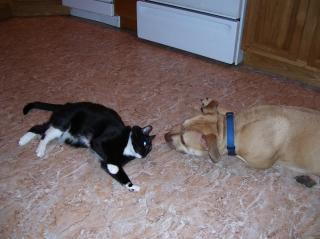Yes to many of these methods.
Securing and familiarization (using the barrier gates and crates to allow them familiarity without the risk of attack).
Distractions (the can) helps to break the mental focus on their prey, but must be followed by a short training session (recall, down or sit stay, heel on or off lead, etc.) to redirect their excitement. The can is not the only solution, though.
He cannot be allowed to fulfill the excitement of his chase (ie, don't let him catch the cat) or he will think of it as a reward. Kind of like a Defensive Lineman sacking the Quarterback, which is real exciting stuff for them.
Consistent reward based training is the key, and something nobody has mentioned. It's both simple and hard at the same time. Check out
http://leerburg.com/playem.htm?name=flv/10-14-2010.flv It addresses some of your dog vs. cat issues. "Reward based training" is simply providing a treat or a toy at the right moment to encourage desirable behavior.
Also, adequate exercise to burn off the dog's extra energy. A sedate walk will probably not be enough. Depending on your dog's physical condition, try a good game of fetch coupled with some light obedience. Or a long jog followed by some tug of war. A really good chew toy, bone, or something like that will help burn off energy (just make sure the dog is not possessive about the chew toy--he should willingly give it up when you take it). When you take it away, do a quick reward based obedience session (eg. make him sit/give him a treat, place into a downstay then call him to you/give him a treat, make him heel and sit/give him a treat).
All dogs are different, what works for one may, or may not, work for others. You need to use what works and discard what doesn't. There is no ONE thing that will work. There may be ONE thing which stands out from the rest, but really it's a multi-prong approach. Think of a chair with four legs; one leg won't hold it up, two won't, three maybe but it will be unstable, but four is comfortable and steady. Think of a wheel; many spokes transfer the energy to the hub and provide stability.
Reward based training should always be happy and fun. If you're doing it right, it will be.
Be positive while you're training with him.
Keep the training sessions short, so you don't both get burnt out and fatigued.
Maintain impeccable consistency with your rewards and discipline.
Dogs don't understand punishment. ("I'm so mad at you right now for chewing my shoe two hours ago while I was at the store. I'm going to yell at you now and throw you in the dog crate for the rest of the day!") They don't get it. It just makes them think you're crazy and not to be trusted.
They need to know you're the one who calls the shots, but they're delighted that you do, because it's fun and engaging and you're a good pack leader.
At some point, the dog should learn to disregard the cat and treat it like a piece of furniture. Occasionally, the cat may do something extremely exciting which gets the dogs attention, you should be able to put the dog into a sit, down, recall, heel, etc. to redirect his focus.
Good luck. Happy training.




